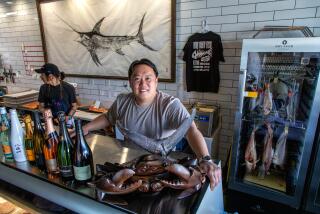When you need help drying out
- Share via
We’re in love with the dried blood oranges they’re selling at farmers markets. The thin, translucent slices are irresistibly tangy and crisp, not to mention gorgeous.
We’re not in love with their price, though ($3 for a tiny packet), or with the price of those cute little cartons of tasty dried fruits and vegetables that health food supermarkets have been cleaning up on.
Blood oranges are in season for another month, and soon the full riches of summer produce will be on us. Restaurants will be garnishing dishes with paper-thin slices of dried ripe tomatoes or eggplant chips. And come to think of it, what could be more appealing next to sauteed wild king salmon than a thin slice of dried Meyer lemon? (We also have about another month for those.)
The flavor of just about anything you dehydrate intensifies; fruits become sweeter. An underripe mango that tastes almost like a raw potato becomes sweet and delicious when dried. Not to mention jerky -- all the rage in the 12-and-younger set.
Suddenly we had to have a dehydrator. But which one to buy? What to look for?
Home food dehydrators replicate the natural process of sun drying by stacking perforated trays over a heating element. Most even go nature one better by circulating the hot air with a fan. We tested four models -- a basic one, two mid-rangers by the largest manufacturer and a sleek model in the over-$100 range. All produced excellent results. The difference was in how long they took.
But that’s also partly your responsibility, because the thinner the food, the faster it dries. Not only does it contain less water, the water doesn’t have to migrate as far to the surface of the food.
Jerky from round steak sliced for milanesa took 3 hours in all the fan-operated machines; flank steak sliced 3/8 inches thick took 12 to 14 hours. Halved Roma tomatoes took two or three times longer than sliced ones because the skin holds in moisture.
These appliances aren’t small, so if storage is a problem, you might want to pass. And there was one missing feature we would have wished for: a timer. It’s found only in more expensive brands, such as the Excalibur which costs around $170, more than we feel most home cooks would want to spend.
*
(BEGIN TEXT OF INFOBOX)
The champ
The Nesco American Harvest Snackmaster Express (model FD-60) has a 500-watt heating element, four perforated trays and one non-perforated tray for making fruit leather. Nesco claims its circulation system makes tray rotation unnecessary.
What’s the difference: This model has a top-mounted 5-inch fan, which gives it that cute R2D2 look.
What we thought: This was the fastest, drying apples, mangoes and cantaloupes in 11 hours, bananas and tomatoes in 12. The top-mounted thermostat was easiest to use.
How much: $39.96, from Wal-Mart.
The price of beauty
L’Equip Food Dehydrator Model 528 was our most expensive. Because it’s rectangular rather than round, it saves space in a cupboard. Conveniently, all six trays come with mesh screens for small items that might slip through regular trays; you also get two half-size fruit leather trays. L’Equip recommends rotating trays if the drying is uneven.
What’s the difference: L’Equip provided the largest drying area, and it’s the only one of these dehydrators to have an on-off switch.
What we thought: Sleek-looking but no speed demon. Though the heating element is 550 watts, it actually dried about 10% more slowly than the Snackmaster Express. Apples, mangoes and cantaloupe dried in 12 1/2 hours, bananas and tomatoes in 14. One irritating lapse: The instruction booklet does not suggest what temperature settings to use, only that the bottom tray should be at least 140 degrees. (Are we supposed to put in a thermometer? And then why are there settings as low as 125 degrees?) We used the same temperatures recommended on the other machines, 135 degrees for fruits and vegetables, 155 for jerky.
How much: $129.95 plus shipping from www.discountvegetarian.com.
Smooth operator
The Nesco American Harvest Snackmaster Pro Food Dehydrator (model FD-50) has specs similar to the FD-60’s plus one mesh screen, and looks much the same.
What’s the difference: The bottom-mounted fan is smaller (4 1/2 inches) and somewhat noisier.
What we thought: Worked more slowly than the Express, about as fast as L’Equip.
How much: $64.95 from Sur la Table, Pasadena.
Slow but sturdy
The Ronco Food Dehydrator dries by convection alone, without a fan. (Ronco also makes a 10-tray model with fan.) This model includes five trays and one fruit leather tray. Since it’s a Ron Popeil product, it comes with a plus-you-get: an elementary but serviceable slicer (with a very sharp exposed blade -- watch your fingers and keep it away from children).
What’s the difference: As Ronco puts it, “No noisy fan with a motor to break down.” Of course, no fan also means this model takes four times as long as fan-powered dehydrators, but the claim is quite true -- with no moving parts, some Roncos have been in use for 15 years.
What we thought: For the patient. Jerky took 24 hours, fruits and vegetables 27 hours (apples and cantaloupe) to 2 days (tomatoes), and you’re supposed to rotate the trays every six hours for even drying. It worked fine, though cleaning the drips from under the heating element was a chore.
How much: $35.99 from www.yahoo.com.
More to Read
Eat your way across L.A.
Get our weekly Tasting Notes newsletter for reviews, news and more.
You may occasionally receive promotional content from the Los Angeles Times.







